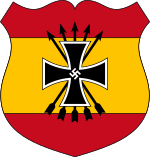
Back الفرقة الزرقاء Arabic División Azul AST Mavi Diviziya Azerbaijani Блакітная дывізія Byelorussian Блакітная дывізія BE-X-OLD Синя дивизия Bulgarian Divisió Azul Catalan Modrá divize Czech Blaue Division German Κυανή Μεραρχία Greek
| 250th Infantry Division ("Blue Division") | |
|---|---|
| 250.ª División de Infantería ("División Azul") 250. Infanterie-Division ("Blaue Division") | |
 Divisional insignia, incorporating Francoist symbols | |
| Active | 24 June 1941 – 10 October 1943 |
| Country | |
| Allegiance | |
| Branch | |
| Type | Infantry |
| Size | 18,000 troops (1941) 45,000 troops (total, 1941–44)[1] |
| Nickname(s) | Blue Division |
| Engagements | |
| Commanders | |
| Notable commanders | Agustín Muñoz Grandes Emilio Esteban Infantes |
The 250th Infantry Division (German: 250. Infanterie-Division), better known as the Blue Division (Spanish: División Azul, German: Blaue Division), was a unit of volunteers from Francoist Spain operating from 1941 to 1943 within the German Army (Heer) on the Eastern Front during World War II. It was officially designated the Spanish Volunteer Division (División Española de Voluntarios) by the Spanish Army.
Francisco Franco had secured power in Spain after the Nationalist victory in the Spanish Civil War (1936–1939), during which the Nationalists received support from Nazi Germany. Franco's authoritarian regime remained officially non-belligerent in World War II but sympathised with the Axis powers. After lobbying by the Spanish Foreign Minister Ramón Serrano Suñer and by senior figures within the Spanish Army following the 22 June 1941 launch of Operation Barbarossa, Franco agreed that Spanish people would be permitted to enlist privately in the German Army and undertook to provide tacit support. An infantry division was raised from Falangist and Spanish Army cadres and was sent for training in Germany. The unit fought on the Eastern Front and notably participated in the 1941–1944 siege of Leningrad, but was withdrawn from the Front after Allied pressure in October 1943 and returned to Spain soon afterwards. Several thousand non-returners were incorporated into the 121st Infantry Division, the short-lived Blue Legion, and eventually into the Waffen-SS.
- ^ Moreno Juliá 2018, p. 193.